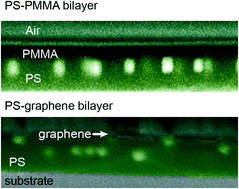当前位置:
X-MOL 学术
›
Mol. Syst. Des. Eng.
›
论文详情
Our official English website, www.x-mol.net, welcomes your
feedback! (Note: you will need to create a separate account there.)
Directed assembly of metal nanoparticles in polymer bilayers†
Molecular Systems Design & Engineering ( IF 3.2 ) Pub Date : 2018-01-25 00:00:00 , DOI: 10.1039/c7me00104e Su-Wen Hsu 1, 2, 3, 4 , Yuhan Long 2, 3, 4, 5 , Aatheya G. Subramanian 2, 3, 4, 5 , Andrea R. Tao 1, 2, 3, 4, 5
Molecular Systems Design & Engineering ( IF 3.2 ) Pub Date : 2018-01-25 00:00:00 , DOI: 10.1039/c7me00104e Su-Wen Hsu 1, 2, 3, 4 , Yuhan Long 2, 3, 4, 5 , Aatheya G. Subramanian 2, 3, 4, 5 , Andrea R. Tao 1, 2, 3, 4, 5
Affiliation

|
The integration of layer-by-layer (LbL) and self-assembly methods has the potential to achieve precision assembly of nanocomposite materials. Knowledge of how nanoparticles move across and within stacked materials is critical for directing nanoparticle assembly. Here, we investigate nanoparticle self-assembly within two different LbL architectures: (1) a bilayer composed of two immiscible polymer thin-films, and (2) a bilayer composed of polymer and graphene that possesses a “hard-soft” interface. Polymer-grafted silver nanocubes (AgNCs) are employed as a model nanoparticle system for systematic experiments – characterizing both assembly rate and resulting morphologies – that examine how assembly is affected by the presence of an interface. We observe that polymer grafts can serve to anchor AgNCs at the bilayer interface and to decrease particle mobility, or can promote particle transfer between layers. We also find that polymer viscosity and polymer mixing parameters can be used as predictors of assembly rate and behavior. These results provide a pathway for designing more complex multilayered nanocomposites.
中文翻译:

聚合物双层中金属纳米粒子的定向组装†
逐层(LbL)和自组装方法的集成具有实现纳米复合材料精确组装的潜力。了解纳米粒子如何在堆叠的材料之间和内部移动对于引导纳米粒子的组装至关重要。在这里,我们研究了两种不同的LbL结构内的纳米粒子自组装:(1)由两个不混溶的聚合物薄膜组成的双层,以及(2)由具有“硬-软”界面的聚合物和石墨烯组成的双层。聚合物接枝的银纳米立方体(AgNCs)被用作模型纳米颗粒系统,用于系统实验-表征组装速率和所产生的形态-研究界面如何影响组装。我们观察到,聚合物接枝物可用于将AgNCs锚定在双层界面上并降低颗粒的迁移率,或可促进层之间的颗粒转移。我们还发现,聚合物粘度和聚合物混合参数可以用作组装速率和行为的预测指标。这些结果提供了设计更复杂的多层纳米复合材料的途径。
更新日期:2018-01-25
中文翻译:

聚合物双层中金属纳米粒子的定向组装†
逐层(LbL)和自组装方法的集成具有实现纳米复合材料精确组装的潜力。了解纳米粒子如何在堆叠的材料之间和内部移动对于引导纳米粒子的组装至关重要。在这里,我们研究了两种不同的LbL结构内的纳米粒子自组装:(1)由两个不混溶的聚合物薄膜组成的双层,以及(2)由具有“硬-软”界面的聚合物和石墨烯组成的双层。聚合物接枝的银纳米立方体(AgNCs)被用作模型纳米颗粒系统,用于系统实验-表征组装速率和所产生的形态-研究界面如何影响组装。我们观察到,聚合物接枝物可用于将AgNCs锚定在双层界面上并降低颗粒的迁移率,或可促进层之间的颗粒转移。我们还发现,聚合物粘度和聚合物混合参数可以用作组装速率和行为的预测指标。这些结果提供了设计更复杂的多层纳米复合材料的途径。











































 京公网安备 11010802027423号
京公网安备 11010802027423号